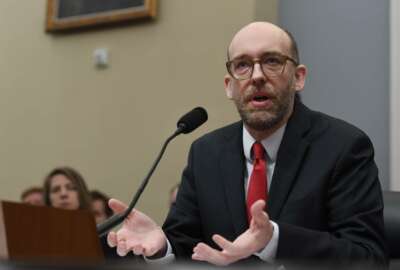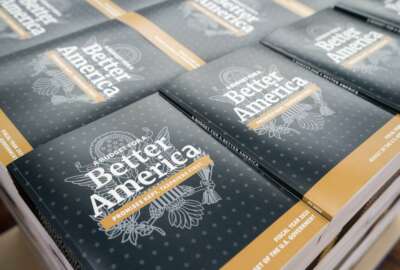
Trump administration sets new expectations for employee awards, performance evaluations
Agencies will develop specific workforce fund plans for the 2021 budget passback, which should detail how they'll reward employees who have in-demand skills or ...
In effort to more strategically reward the best of the best within the federal workforce, the Trump administration wants agencies to rethink how — and who — they recognize with employee awards and bonuses.
New guidance, which the administration released late last week, describes how agencies should reevaluate their employee awards programs and develop evidence-based plans to reward the very best with limited funding.
The guidance also serves as a reminder: perhaps not all employees are performing in a way that justifies a top rating.
First, the administration has directed all agencies to develop specific workforce fund plans, which will serve as a base line for how each department will reward and recognize employees who have made special contributions to their organizations.
The goal, as acting Office of Management and Budget Director Russell Vought and acting Office of Personnel Management Director Margaret Weichert explained in new guidance, is to help agencies more strategically reward employees within their workforces whose performance is truly outstanding or who have in-demand skills that are difficult to find.
“The ongoing use of awards and recognition throughout the year is particularly important as agencies address workforce challenges and look for opportunities to reward and recognize high performing employees and those with talent critical to mission achievement,” the acting directors wrote in a July 12 memo. “Currently, most awards are tied to rating-based performance awards. We encourage agencies to reexamine, and adjust as appropriate, the balance between rating-based awards and individual contribution awards (e.g., special act awards). When granting rating-based awards, agencies should allocate awards in a manner that provides meaningful distinctions in performance.”
In developing these workforce fund plans, OMB wants agencies to explain how they’ve evaluated and adjusted “the balance between rating-based awards and individual contribution awards,” if appropriate.
Separate guidance from OPM specifies how exactly agencies should view these rating-based employee rewards.
“In order to recognize high performers, agencies should allocate awards in a manner that provides meaningfully greater rewards to top performers,” Weichert wrote in a separate July 12 memo. “Agencies should ensure only employees who have demonstrated the highest levels of individual performance receive the highest ratings of record and the highest performance awards. This is implemented most effectively when performance plans contain rigorous performance standards upon which employee performance will be assessed.”
What makes a fully successful or outstanding employee?
OPM went on to specify exactly who should be in line to receive top recognition from their agencies. Only the best should receive top recognition and honors from their agencies, Weichert said.
“By law, forced distribution of employees among levels of performance, or grading on the curve, is prohibited, because employees are required to be assessed against documented standards of performance versus an individual’s performance relative to others,” she said.
The latest memo from Weichert doesn’t direct agencies to undergo a massive overhaul of their employees’ performance standards and evaluations. Instead, the guidance serves more as a reminder for agencies to reevaluate how they’re defining performance standards and the specific activities and quantitative goals employees should have completed to achieve a certain rating.
OPM also provided more clarity on the kind of performance the administration expects of employees who earn specific ratings.
“Performance at the ‘fully successful’ level is a positive notation,” Weichert said. “Fully successful individuals deliver on behalf of our citizens, meeting prescribed objective, measurable outcomes relating to the duties that they perform. ‘Fully successful’ should be seen as the category for employees who are meeting valid performance standards designed to deliver on what the American public should expect from their civil servants.”
Employees who earn an “exceeds fully successful” rating should perform in a way that’s measurably beyond the standard set by employees at the “fully successful” level, OPM said. A federal employee with a “exceeds fully successful” rating may, for example, be proactive about detecting a problem within his or her organization, whereas a “fully successful” employee may deal with that problem in a responsible way.
Federal employees who earn an “outstanding” rating perform at a level that goes beyond that of an “exceeds fully successful” rating, OPM added.
“An ‘outstanding’ performance rating could be reflective of how an employee delivered extraordinary results or sustained a high level of performance during a highly demanding period or within a challenging environmental context, such as during a time of transition or undue pressure from extenuating circumstances or unique mission requirements,” Weichert’s memo reads.
Again, OPM’s latest guidance isn’t a serious departure from existing thought on federal employee performance evaluations and standards. But OPM’s new memo acknowledges a point that some within the federal community — and especially some lawmakers in the aftermath of the 2014 wait time scandal at the Department of Veterans Affairs — have questioned.
Citing 2013 data, the Government Accountability Office found more than 99% of federal employees had achieved a performance rating of “fully successful” or above. Less than 0.5% of employees had earned a “minimally successful” or “unacceptable” rating, according to GAO, which published the data back in 2016.
Consider this data against feedback from the most recent Federal Employee Viewpoint Survey, and the Trump administration sees a disconnect.
Roughly 38% of federal employees said differences in performance at their agencies are recognized in a meaningful way, and 46% said awards given within their work units depend on how well employees perform their jobs, according to 2018 FEVS.
OMB, OPM sets expectations with workforce fund plans
All told, the Trump administration wants agencies to more closely evaluate how they’re rating their employees. Only the best should get the best performance ratings, which should be reflected in the new workforce fund plans that agencies will submit to OMB in the fall, according to the administration’s guidance.
Agencies should project how much they expect to spend on employee awards and recognition programs in 2020 and in future years, Vought and Weichert said.
The workforce fund plans should also describe:
- How the plans align with their strategic goals and support organizational values,
- How they will improve mission outcomes and organizational performance,
- How departments will use evidence-based methods to issue awards and determine their amount, and,
- How agencies will determine the effectiveness of the awards and recognition programs.
Moving forward, agencies will use these workforce fund plans to inform how — and who — they recognize with a performance-based bonus or reward.
These awards would apply to most federal employees, except political appointees, where discretionary awards for employees on the Executive Schedule have largely been frozen since 2010.
Agencies will continue to reward members of the Senior Executive Service based on existing laws and regulations, according to the OPM/OMB guidance. But prior guidance on rewards and recognition for agencies has been rescinded.
OMB will review workforce fund plans with agencies’ fiscal 2021 budget submissions.
OMB initially teased this guidance in the President’s 2020 budget request back in March.
It’s part of the Trump administration’s goal to shift away from across-the-board pay raises for all federal employees and instead focus more on strategic ways to reward certain workers, particularly those who have in-demand skills or have made recognized contributions to their agencies.
It’s not the first time the administration has suggested new ways to reward top-performers. OMB requested $1 billion for the creation of a new workforce fund as part of the President’s 2019 budget proposal, but Congress didn’t appropriate new money for governmentwide, performance -based bonuses.
Agencies today spend about 1% of their payroll on employee awards and recognition, according to the President’s 2020 request. The administration has said it sees room for agencies to more strategically use that funding to administer employee awards and recognition programs.
Copyright © 2024 Federal News Network. All rights reserved. This website is not intended for users located within the European Economic Area.
Nicole Ogrysko is a reporter for Federal News Network focusing on the federal workforce and federal pay and benefits.
Follow @nogryskoWFED
Related Stories





